|
|
|
Sort Order |
|
|
|
Items / Page
|
|
|
|
|
|
|
| Srl | Item |
| 1 |
ID:
193568
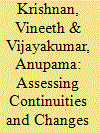

|
|
|
|
|
| Summary/Abstract |
Japan announced its new space security blueprint in June 2023. The new blueprint lays down a ten-year roadmap for the country to enhance the utilization of space for its military. While the announcement has been widely perceived as a ‘first’, it is in fact a crystallization of Japan’s space security strategies over the last few decades. This article interprets the blueprint in light of Japan’s counterstrike doctrine. It traces Japan’s rise as a military space power since the 1970s and analyses its evolving approach to space security. Continuities and changes in the 2023 blueprint are assessed against Japan’s historic policies.
|
|
|
|
|
|
|
|
|
|
|
|
|
|
|
|
| 2 |
ID:
167636
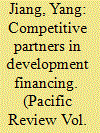

|
|
|
|
|
| Summary/Abstract |
In the aftermath of the global financial crisis, with the world in search for new economic engines, China and Japan have explicitly given their answer through their expansion of overseas infrastructure investments. This study focuses on the flagship sector of high-speed railways (HSR) and examines what kinds of development financing China and Japan have adopted in making these investments. It asks the following questions: What similarities are there in the Chinese and Japanese approaches to investments in overseas infrastructure, and how do they differ from traditional Western development financing? Also, in what ways have China and Japan changed their approaches to overseas infrastructure projects during this process? It argues that in the process of expanding overseas infrastructure investments and competing for infrastructure projects, China and Japan have become ‘competitive partners’ in challenging the traditional norms of development financing represented by the Washington Consensus and the Development Assistance Committee (DAC). To be more specific, China and Japan have adopted each other’s practices of tied commercial financing, heavy government involvement, focusing on physical infrastructure and industrialization, and showing respect for host-country forms of governance. In particular, by joining China in the new game of exporting infrastructure and through its own ‘quality infrastructure investment’ initiative, Japan has broken out of the constraints of DAC norms as an aid donor and endorsed some fundamental Chinese approaches to development and development cooperation, which in their turn were inspired by earlier Japanese practices.
|
|
|
|
|
|
|
|
|
|
|
|
|
|
|
|
| 3 |
ID:
160970
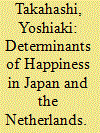

|
|
|
|
|
| Summary/Abstract |
It is often said that the Japanese happiness is lower than that of Europeans. However, sufficient discussion has yet to take place with consideration of differences in social forms as a background factor. In this study, therefore, by leveraging comparative international surveys, we empirically study and compare the factors that affect happiness in Japan and in the Netherlands, a country which has a higher happiness level than other European countries, from both macro (country level) and micro (individual level) perspectives.
|
|
|
|
|
|
|
|
|
|
|
|
|
|
|
|
| 4 |
ID:
158054
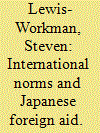

|
|
|
|
|
| Summary/Abstract |
Do norms influence Japan's foreign aid? Japan's aid policy statements have increasingly emphasized humanitarian and democratic values, but few studies demonstrate a shift in Japan's aid policy that reflects this changing discourse. In this study, I seek to determine if Japan's foreign aid commitments increasingly reflect normative factors or continue to be allocated based on commercial or security considerations. The results indicate that humanitarian and democratic values had very little influence on Japan's foreign aid commitments over the entire analysis period. Contrary to conventional wisdom, commercial benefits had little importance before 1992 and are a significant factor only during the 1992–2001 period. Security considerations are strong predictors during the Cold War period and are even more significant after 2001 when Japan's foreign aid became increasingly aligned with US security policies. Further, Japan has not substantially increased the share of its aid to “soft” sectors or disaster response, but it has adopted the international norm of debt relief for highly indebted poor countries and shifted a substantial amount of foreign aid from infrastructure lending to debt forgiveness.
|
|
|
|
|
|
|
|
|
|
|
|
|
|
|
|
| 5 |
ID:
176224
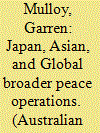

|
|
|
|
|
| Summary/Abstract |
This paper examines Japanese unity of Overseas Despatch Operation (ODO) actors, laws, and operational aspects, interaction with state and institutional actors, ‘4C’ functional regional engagement and concepts of partnership, and Japan’s United Nations Peace Operations-Humanitarian Assistance Disaster Relief Operations (UNPO-HADRO) nexus. Japanese cooperation for dual liberal-international peace and realist security goals within increasing regional strategic competition and nationalist antipathy is examined, particularly in Japan’s ‘poor neighbourhood’. The paper questions why, despite undoubted expertise, Japan has not emerged as a regional UNPO-HADRO development leader, and whether Japanese UNPO-HADRO and ‘pro-active pacifism’ approaches are utilising UNPO-HADRO for Asia-regional strategic competition purposes? Japanese ODO have played important functional engagement, value sharing, and institutional socialisation roles, with integrated legal-civil–military holistic approaches providing models for others and foundations for partnerships. However, despite specialist capacity-building knowledge transfer efforts Asian disquiet remains concerning cooperation and partnership. Japan remains highly risk-averse, raising questions regarding its dependability, and ‘HADRO-CIMIC superpower-aspirations’, or bridging-actor role between Indo-Pacific and ‘Northern-Developed’ practitioners, can be evaluated by Japan’s modest present UNPO actor status. Japanese leadership and initiative is limited by its neighborhood and attendant institutions, but also by its self-perceived identity shaped by historical, alliance, and leadership challenges to manage relative decline.
|
|
|
|
|
|
|
|
|
|
|
|
|
|
|
|
| 6 |
ID:
159426
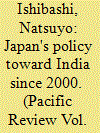

|
|
|
|
|
| Summary/Abstract |
Japan's policy toward India since 2000 appears to be a sign of new directions in Japan's security policy since its decision to establish a strategic partnership with India is different from the previous policy of exclusive bilateralism centering on the US–Japan alliance. Nonetheless, Japan's recent security partnership with India is part of Japan's long-term effort to support the US-led liberal political and economic order in East Asia. This paper argues that Japan's policy toward India since 2000 has evolved toward becoming fully aligned with US policy toward the Indo-Pacific region. The critical shift in Tokyo's policy toward India came in spring 2005, when Japanese political leaders and policy elites came to recognize India as an important balancer against China as a result of the violent anti-Japanese demonstrations in China. They decided to support including India into the East Asian Summit and incorporated India into their new values diplomacy. This shift in Japan's policy toward India, along with efforts to increase interoperability between Japan's Maritime Self-Defense Forces and Indian Navy, coincides with US strategy to bring India into the US-led coalition to balance against China.
|
|
|
|
|
|
|
|
|
|
|
|
|
|
|
|
| 7 |
ID:
155093
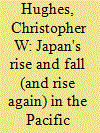

|
|
|
|
|
| Summary/Abstract |
Japan has featured prominently in The Pacific Review (TPR) since the journal's inception; and the very first issue in 1988 was essentially a Japan special issue with four out of six articles devoted to considering the implications of the country's then seemingly relentless rise as a regional and increasingly global power. Thereafter, TPR has carefully documented Japan's changing international pathway, forming indispensable reading for all Japan experts. TPR has always been distinguished by a rare ability to question the conventional wisdom on the study of Japan.
|
|
|
|
|
|
|
|
|
|
|
|
|
|
|
|
| 8 |
ID:
159424
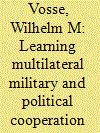

|
|
|
|
|
| Summary/Abstract |
n January 2009, the Japanese government decided to join the multilateral-force counter-piracy operations in the Gulf of Aden and the coast of Somalia and has since then developed into one of the most active and involved forces combatting maritime piracy. This special issue defines de-centering as a ‘process of moving away from a state of centering by building relationships with other partners’ through ‘security and defense consultations and dialogues’. This article argues that this counter-piracy mission involved many if not all of these components and can be seen as an important opportunity for Japan to deepen its understanding of forces and governments of countries and forces other than the United States in various dialogue and coordination forums, joint capacity building, and joint training exercises. While it is not argued that this will in any way weaken US–Japan relations or the role of the United States as Japan's main security guarantor, it demonstrates that Japan and the Self Defense Forces can become a security partner for countries in Europe or NATO. This potentially gives Japan more options whether to support or not support specific foreign policy decisions by the United States, a condition for de-centering.
|
|
|
|
|
|
|
|
|
|
|
|
|
|
|
|
| 9 |
ID:
147393
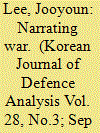

|
|
|
|
|
| Summary/Abstract |
Since the 2000s Japan’s defense and security policy has undergone a historic shift, including a series of military expansions, the government’s 2014 approval of a reinterpretation of Article 9 of the postwar Constitution, and the Diet’s passage of security bills in 2015. This poses a question regarding how it was possible for all these changes to occur, if the long-held domestic norm of antimilitarism had persisted. This article examines Japan’s domestic normative context between 2001 and 2013 by analyzing the discursive constructions of Japanese war memory by editorials of two representative newspapers, Yomiuri Shimbun and Asahi Shimbun. It is found that Yomiuri supports the shift for military expansions as compatible with the postwar stance of a pacifist nation with the interpretation that the Japanese war contributed to independence movements in Asia. This is contrasted with Asahi, which opposes the change with a view that Japan’s war was an aggression. This article argues that the emerging discursive practices represented by Yomiuri produced the normative context that appealed to the distinctive target audience in such a way to operate as a precondition for the Japanese government to shift its defense and security policy. This raises the importance of the domestic factor in understanding Japan’s momentous changes in security, adding more nuances to the conventional focus on external factors.
|
|
|
|
|
|
|
|
|
|
|
|
|
|
|
|
| 10 |
ID:
170237
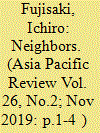

|
|
|
|
|
| Summary/Abstract |
This article discusses Japan-Republic of Korea relations since 1965 with focus on an issue that has returned to the forefront of debate. In a recently convened symposium between two leading think tanks, the chairmen of the two participating organizations proposed principles for improving Japan-ROK relations going forward.
|
|
|
|
|
|
|
|
|
|
|
|
|
|
|
|
| 11 |
ID:
167755
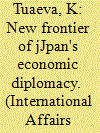

|
|
|
|
|
| Summary/Abstract |
ECONOMIC DIPLOMACY as a phenomenon of international life has been attracting numerous analysts as it unfolds against the background of the rapidly changing situation in the world economy and practices of individual countries that suggest their own interpretations and create new instruments.
|
|
|
|
|
|
|
|
|
|
|
|
|
|
|
|
| 12 |
ID:
156585


|
|
|
|
|
| Summary/Abstract |
This article analyzes Japan's development of civilian nuclear energy and its potential for developing nuclear weapons in the late 1960s. First, it examines two technological studies of Japan's nuclear fissionable material production capability: one sponsored by the Japanese government and the other sponsored by the US government. A comparative analysis of them reveals that the Japanese study did not investigate the full range of feasible measures toward Japan's nuclear armament. Further scrutiny of Japanese nuclear-energy development in relation to its policy-making structure at that time draws out the following arguments: (1) Japan's civilian nuclear program clearly contributed to its acquisition of a latent nuclear weapon potential; (2) Japan had not deliberately developed the latent capability, which reflected the lack of coordination among political actors; (3) Japan increased its dependence on the United States in the nuclear-power field, making its pursuit of nuclear weapons politically more difficult. This case study of Japan illustrates not only the intricate relationship between the development of civilian nuclear power, the development of nuclear-weapon potential, and the proliferation of nuclear weapons, but also the effects of the state’s nuclear-policy-making structure on its nuclear posture.
|
|
|
|
|
|
|
|
|
|
|
|
|
|
|
|
| 13 |
ID:
193338
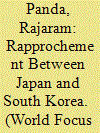

|
|
|
|
|
| Summary/Abstract |
Responding to Yoon’s positive action, Kishida flew to Seoul on 7 May for a summit with Yoon. This dynamic movement with two summits within two months between the leaders of Japan and South Korea were indeed significant as they marked the first resumption of mutual visits in 12 years, with both sides resolved to bury the past and work towards a future-oriented society. After dealing with the past historical issues, both sides discussed global issues and the latest developments in the Indo-Pacific region, including North Korea. The objective was to build on the momentum to improve bilateral relations, including national security and financial matters with a future-oriented outlook.9 Kishida invited Yoon to attend the G-7 summit that Kishida hosted in his hometown of Hiroshima on 10 May 2023.
|
|
|
|
|
|
|
|
|
|
|
|
|
|
|
|
| 14 |
ID:
167637
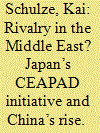

|
|
|
|
|
| Summary/Abstract |
Ever since the so-called rise of China has started, Sino-Japanese relations have been increasingly described as a rivalry between both states. For the most part, this assumed rivalry has been analyzed on the global level or within the boundaries of the East Asian region, while the consequences of this rivalry for other world regions, such as the Middle East, have been largely neglected in the literature. In order to fill this gap, this article investigates how China’s growing presence in the Middle East, and in particular regarding the Israeli-Palestinian conflict, influences Japan’s own foreign policy in this troubled region. It utilizes a modified concept of the strategic rivalry approach, called ‘asymmetric rivalry’, which challenges the widespread notion that rivalry needs to be mutually perceived by both sides and thus analyzes the assumed Sino-Japanese rivalry in the Middle East from a Japanese perspective. By focusing on the case of Japan’s CEAPAD initiative, which aims at coordinating East Asian countries’ developmental assistance towards the Palestinian Authority while deliberately excluding China, the present article shows that the perception of Japan’s foreign policy elite of China as a rival decisively influences how Japan’s foreign policy is shaped in the context of the Israeli-Palestinian conflict.
|
|
|
|
|
|
|
|
|
|
|
|
|
|
|
|
|
|
|
|
|